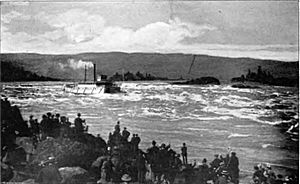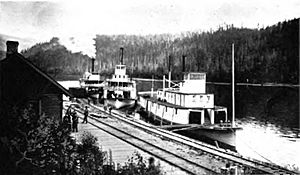James William Troup facts for kids
James William Troup (born February 5, 1855 – died November 30, 1931) was a famous American steamboat captain. He also helped manage the Canadian Pacific Railway and was a pioneer in shipping, meaning he helped start new ways of moving goods and people by water.
Contents
- Meet the Troup Family
- Starting His Career on the Water
- Navigating Tricky Rapids
- First Adventures in British Columbia
- Back to Oregon and New Ship Designs
- The Famous Hassalo Run
- Steamboat Operations in British Columbia
- Building Ships for the Klondike Gold Rush
- Leading Canadian Pacific Steamships
- His Final Years
- Loyalty to Captain Irving
Meet the Troup Family
James William Troup was born in Portland, Oregon, in February 1855. His father, Captain William H. Troup, was also a well-known steamboat captain in the Pacific Northwest. James's grandfather, Captain John Turnball, was a sailing ship captain.
James had a younger brother, Claud Troup, who also became a skilled steamboat captain. James Troup's son, Roy Troup, followed in their footsteps and became a steamboat captain too. It was a family tradition!
Starting His Career on the Water
James Troup learned a lot about steamboats from his father. Together, they helped build many of the first steamboats on the Columbia River.
In 1872, at just 17 years old, James started working on the steamer Vancouver. By the time he was 20, he had worked every job on a steamboat, from deckhand to captain. He then became the captain of a small steamer called Wasp.
Troup later worked for the Oregon Steam Navigation Company on the Columbia River. He started as a purser, handling money and tickets, and later became a master (captain). In 1878, when he was only 23, he was made captain of a big new steamer called the first Harvest Queen.
In the early 1880s, railways began to be built along the Columbia River. The Oregon Railway and Navigation Company, which had bought out the O.S.N., started moving its boats to other areas. This often meant sailing the boats through dangerous rapids like Celilo Falls or the Cascades.
In 1881, Captain Troup bravely steered the Harvest Queen over Celilo Falls, where the boat was almost destroyed. He then took it through the Cascades. In the same year, he also guided the Idaho through the Cascades.
First Adventures in British Columbia
In 1883, Troup began working in British Columbia, Canada. He worked for J. A. Mara, who owned two steamboats, the Peerless and Spallumcheen. These boats ran on Kamloops and Shuswap lakes and the Thompson River.
Captain Troup also earned the trust of another skilled captain, John Irving. Irving put Troup in charge of his main steamer, the William Irving, which was named after Captain Irving's father. Irving also gave Troup command of the huge and challenging sidewheeler Yosemite. This ship sailed the route from Victoria to New Westminster.
Back to Oregon and New Ship Designs
Troup worked with John Irving and the Canadian Pacific Navigation Company until 1886. He then returned to Oregon to manage the Oregon Railway and Navigation Company, which was owned by the Union Pacific Railroad.
From 1886 to 1892, Troup oversaw the building of many steamboats. One of the most famous was the T.J. Potter. In 1891, the Victorian was launched in Portland, Oregon. This ship was very large for one made entirely of wood. However, it wasn't powerful enough, and it became one of Troup's few design mistakes.
The Famous Hassalo Run

On May 26, 1888, Captain Troup took the sternwheeler Hassalo through the Cascades of the Columbia River. He covered the six miles of fast-moving whitewater in just seven minutes!
Other captains had also navigated the Cascades, and some even beat Troup's time, like Captain John McNulty (steamboat captain) on the R.R. Thompson years earlier. However, the Hassalo's famous run was special because 3,000 people watched it, and it was captured in a well-known photograph.
Steamboat Operations in British Columbia
While Troup was in Oregon, his Canadian friends John Irving and J.A. Mara, along with others, formed the Columbia and Kootenay Steam Navigation Company. Mara convinced Troup to come back to Canada to manage their operations on the large inland lakes of British Columbia.
Troup returned to Canada in March 1892 and started his new job in Nelson, BC. He designed many of the inland steamboats used on the lakes. Each boat was built for a specific job, like towing other vessels or carrying passengers.
One of Troup's most successful designs was the steamer Rossland. Historian Professor Turner called it the most beautiful ship ever to sail on the Arrow Lakes. When Mara's company was bought by the Canadian Pacific Railway, Troup continued to be in charge.
Building Ships for the Klondike Gold Rush
When the Klondike Gold Rush started in 1898, there was a huge need for ships. The Canadian Pacific Railway (CPR) put Troup in charge of building steamboats.
Troup went to Port Blakeley, Washington, to oversee the building of four sternwheelers. These ships were meant for the Yukon and Stikine rivers. They were named Constantine, Walsh, Dalton, and Schwatka.
Only the Schwatka made it to Alaska, and that was in 1904. The Constantine sank while being towed, and the Walsh and Dalton stayed in Puget Sound and on the Columbia River. Troup also supervised sternwheeler building in False Creek, BC and Vancouver, BC. Only three of the Vancouver boats actually worked on the Stikine River. After this, Troup returned to the Kootenay area, where in 1901, he became the superintendent for both steamboat and rail lines.
Leading Canadian Pacific Steamships
In 1901, the CPR bought John Irving's company, the Canadian Pacific Navigation Company. Troup was moved to Victoria, B.C., to take charge of the shipping operations that his old boss, John Irving, had started.
This new role was a huge challenge for James Troup for the rest of his career. He used his skills as a ship designer and his ability to convince people to build some of the best coastal ships ever seen on the Pacific Coast.
Around this time, a place called Five Mile Point near Nelson was renamed Troup Junction in his honor.
Troup's long career was closely connected with the CPR from then on. In 1903, he was named Superintendent of the British Columbia Coast service for the Canadian Pacific Railway.
The company faced many challenges over the years. One was a tough price war in 1909 with the Puget Sound Navigation Company, led by Troup's friend Joshua Green. Even though their companies were fighting, Troup and Green agreed never to talk about the price war so it wouldn't affect their friendship.
Troup is known for coming up with the idea and building the CPR's famous Princess fleet of ships. By 1913, 10 of the 12 Princess ships in the coastal fleet had been built because Captain Troup ordered them.
The saddest event for Captain Troup during his time with the CPR was the terrible sinking of the Princess Sophia. That ship ran aground on Vanderbilt Reef in Lynn Canal on October 23, 1918. Even though rescue ships were nearby, the weather was too rough to get anyone off the Sophia.
During the night of October 25, the storm got worse. The Sophia was blown off the reef and sank, taking all 343 people with her. The loss of the Sophia was the worst disaster in the history of the Canadian west coast and Inside Passage shipping. It deeply affected Captain Troup and caused him to become ill for a long time.
His Final Years
Captain Troup retired in August 1928. He was 73 years old, which was eight years past the CPR's normal retirement age. By this time, the CPR had a fleet of successful modern steamers serving the west coast of Canada, Alaska, and Puget Sound. This was largely thanks to Captain Troup's hard work.
In 1929, when he was 74, Captain Troup made his last whitewater run. The captain of the Lewiston gave Troup the great honor of asking him to pilot the ship through the lower Cascades. Captain Troup passed away on November 30, 1931. Many believe no other person did more for shipping in the Pacific Northwest.
Loyalty to Captain Irving
Perhaps Captain Troup's only equal in skill and respect was his good friend and former boss, John Irving. Captain Irving lived until 1936. Like Troup, Captain Irving had an adventurous life, but he was not good with money and often gave away or gambled his fortune. His only son was killed in World War I, and a heartbroken Irving, who was too old for military service, offered to take his son's place.
In his later years, Captain Irving had no real home. When he sold his company to the CPR in 1901, they gave him the right to travel for free on their ships. Since he had no home on land, Captain Irving used this right constantly, almost living on CPR ships.
There might have been questions about whether his free travel right extended so far. But as long as Captain Troup was the superintendent of CPR steamships, he made sure Captain Irving was always welcome on every ship in the fleet. After Troup retired, his replacement tried to limit Captain Irving's travels by saying he could travel for free, but he would have to pay for meals and a bed. However, the ship captains always ignored this rule, and Captain Irving always had a cabin and was welcome at every captain's table, just as Captain Troup had wanted.




